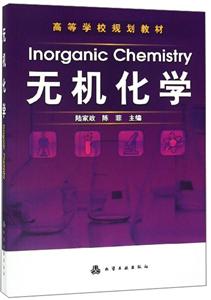-
>
宇宙、量子和人类心灵
-
>
(精)BBC地球故事系列-星际旅行
-
>
从一到无穷大
-
>
图说相对论(32开平装)
-
>
一本有趣又有料的化学书
-
>
刘薰宇的数学三书:原来数学可以这样学全3册
-
>
光学零件制造工艺学
无机化学 版权信息
- ISBN:9787122062505
- 条形码:9787122062505 ; 978-7-122-06250-5
- 装帧:一般胶版纸
- 册数:暂无
- 重量:暂无
- 所属分类:>>
无机化学 本书特色
本书针对药学类专业无机化学的双语课程,将无机化学课程的基本内容进行精选,结合国内高校教学实际,删除原版教材中大量的复杂、繁琐及较深奥的部分,力求使之既能体现无机化学课程的专业基础课特色,又可提高学生的英语应用能力。 鉴于医药学专业学生理论与实验课程并重的特点,全书包含两大部分:Ⅰ Inorganic Chemistry与Ⅱ Inorganic Chemical Experiments。Part Ⅰ includings thirteen chapters:1 Introduction,2 Structures of Atoms,3 Chemical bonds,4 Thermochemistry,5 Chemical Kinetics,6 Chemical Equilibrium,7 Solutions,8 Solubility Equilibrium,9 AcidBase Equilibria,10 An Introduction to Electrochemistry,11 Chemistry of Coordination Compounds,12 Nonmetals and Semimetals,13 Metals。Part Ⅱ includings three chapters:1 Basic Techniques of Experimental Chemistry,2 Typical Chemical Laboratory Apparatus,3 Experiments。 本书可作为高等院校本科药学及化学类相关专业的无机化学双语教材,也可作为化学专业英语课的教材或参考书。
无机化学 内容简介
《无机化学/高等学校规划教材》针对药学类专业无机化学的双语课程,将无机化学课程的基本内容进行精选,结合国内高校教学实际,删除原版教材中大量的复杂、繁琐及较深奥的部分,力求使之既能体现无机化学课程的专业基础课特色,又可提高学生的英语应用能力。鉴于医药学专业学生理论与实验课程并重的特点,《无机化学/高等学校规划教材》包含《无机化学/高等学校规划教材》可作为高等院校本科药学及化学类相关专业的无机化学双语教材,也可作为化学专业英语课的教材或参考书。
无机化学 目录
- >
龙榆生:词曲概论/大家小书
龙榆生:词曲概论/大家小书
¥9.1¥24.0 - >
二体千字文
二体千字文
¥16.0¥40.0 - >
我与地坛
我与地坛
¥25.8¥28.0 - >
大红狗在马戏团-大红狗克里弗-助人
大红狗在马戏团-大红狗克里弗-助人
¥4.4¥10.0 - >
企鹅口袋书系列·伟大的思想20:论自然选择(英汉双语)
企鹅口袋书系列·伟大的思想20:论自然选择(英汉双语)
¥6.3¥14.0 - >
罗庸西南联大授课录
罗庸西南联大授课录
¥21.1¥32.0 - >
山海经
山海经
¥20.4¥68.0 - >
小考拉的故事-套装共3册
小考拉的故事-套装共3册
¥35.4¥68.0
-
2022图书×抽奖盲袋
¥9.9¥25 -
2023读书月阅读盲盒——天黑,闭眼,刀谁?
¥42.3¥158 -
2022读者节纪念徽章-三星会员专属
¥45¥45.6 -
2023读书月阅读盲盒——我什么场面没见过?
¥42.3¥158 -
2023读书月阅读盲盒——去码头整点什么薯条?
¥42.3¥158
北京高质量发展报告:2022:2022
¥126.0¥168.0进化算法及其在智能配电网中的应用
¥68.6¥98.0寻找灯塔:建筑、自然与人类的集体记忆
¥35.4¥58.0速成围棋考级蓝宝书(4段篇)
¥21.5¥39.0汽车电工电子技术及应用
¥17.9¥32.0















